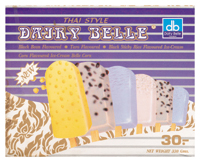
Although blueberry products continue to hit the market, including yogurts, juice drinks and confectionery, there is evidence that pomegranate is taking over as the top fruit. Pomegranate is believed to have benefits, especially to women's health issues, thanks to its estrogen content. Among the recent launches are Zakuro Roll from Dai Ichiya, a soft sweet roll filled with pomegranate and whipped cream, and Oen Sanka juice drink from Sapporo, which contains prune, blueberry and pomegranate juice.
In the Japanese confectionery market, Pola Foods has added an anthocyanin-rich blueberry sweet to the Post Pet range, while Asahi Pharmaceuticals has introduced Cool Dental Candy, a functional soft candy containing xylitol and apple polyphenol.
In 1999, Kao introduced Kenco Econa cooking oil in Japan, recognized as a FOSHU product (designated health promoting food product) by the government. The oil is claimed to be less likely than other oils to turn into fat in the body, and contains 80% diacylglycerol (DAG) from soy and rapeseed.
Last year, the oil
appeared as an ingredient in other food products in Japan. Yamazaki
Baking introduced E-Roll bread rolls, containing 10% Econa cooking
oil, while Hagoromo Foods launched Sea Chicken L Flakes, a canned
mix of tuna and chicken in Econa oil. (Last month, Archer Daniels
Midland signed a letter of intent with Kao to form a 50/50 joint
venture in the U.S. for the manufacturing and marketing of the DAG
oil as an ingredient for food processors.)
Drink to your Health
Jelly drinks are a well-established segment of the beverage market in Japan and are particularly used as a carrier for functional and health-oriented ingredients. Morinaga has a range of health-oriented jelly beverages under the Wieder brand, including a line targeted at women concerned about nutrient deficiencies in their diet.The three-item line includes Collagen, an orange-flavored product with 3.5 g collagen plus vitamin C; Fat Burner, passionfruit flavored, with a protein peptide said to help burn fat; and Fiber, an apple-flavored drink with dietary fiber to aid digestion. All are packaged in Cheer Pack pouches with screw-top closures, making them ideal for drinking (or is it eating?) on the move. The fiber variety is based on the company's Body Pleasure Fiber In, a jelly drink containing natural vegetable fibers, launched earlier in 2000.
Ovaltine, the hot beverage mix from Novartis Nutrition, was introduced last year in Singapore and Malaysia in a new Smart variety for children. The chocolate-flavored mix is formulated with an ingredient called EMC2, which is described as a "nutrient interactive system" and is said to help children grow both mentally and physically. The product also contains folic acid, zinc, iron, iodine, taurine, choline, and vitamins A, B, C, D and E. The package shows an image of a child graduating to highlight the product's mental enhancing capabilities.
In Japan, Asahi Soft Drinks introduced Switch, a "conditioning water" containing polyphenols and minerals. What sets the product apart from other enriched waters is that it is positioned as a sports drink. The product's polyphenols have antioxidant properties which are said to help restore the body and combat the damage caused by active oxygen generated during exercise. Switch is available in cans, PET bottles, cartons and pouches, and the brand also includes polyphenol- and mineral-enriched lemon candies.
Also new is DyDo Drinco's
Miu, a citrus-flavored isotonic drink made with deep-sea water from
off the coast of Japan and said to be rich in minerals including
magnesium.

Funky Flavors
Asian markets are often a rich source of interesting flavor combinations, challenging the perceptions of both consumers and product developers in the West. Examples in China include a spicy chicken-flavored butter cookie from Jessica Foods, and Sam's Garden coffee-flavored, caramel-coated pea-nuts. In Thailand, Dairy Belle introduced a line of Thai-style stick ice creams in several varieties, including black bean and black sticky rice.Potato was featured as an ingredient in two new health-oriented bakery products. In Japan, Pola Foods extended its Post Pet savory crackers with a new potato salad variety, containing a third of the RDA of four vitamins and vegetable fiber. In Indonesia, PT Monde Mahkota introduced Nissin branded Potatoz Bola-Bola cookies, round cookies made with potato starch and wheat flour, and rich in omega 3.
Several novel ideas appeared in the Japanese gum market in recent months. Kanebo introduced Irairado Jikken, a chewing gum that changes color from green to an increasing shade of red, according to the consumer's level of stress. The package incorporates a "stress meter."
Bourbon introduced a Hello Kitty branded chewing gum in an "animated" package. Every time a piece of gum is removed from the package, the cat appears to wink. PF